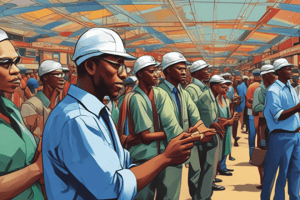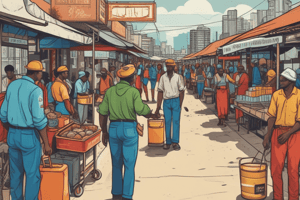Podcast
Questions and Answers
What motivated the change of title in the book?
What motivated the change of title in the book?
- The new Labour Relations Act (correct)
- The rise of employment in the service sector
- The establishment of the National Economic, Development and Labour Council
- The decline of unionisation in the manufacturing industry
What was the main focus of the fourth edition of the book?
What was the main focus of the fourth edition of the book?
- The impact of globalisation on the workforce
- The new Labour Relations Act (correct)
- Labour relations in the manufacturing industry
- Employee participation in the service sector
Who led the task team that compiled the Labour Relations Act?
Who led the task team that compiled the Labour Relations Act?
- A committee of labour unions
- Halton Cheadle (correct)
- The National Economic, Development and Labour Council
- The Minister of Labour
When was the Labour Relations Act approved by Parliament?
When was the Labour Relations Act approved by Parliament?
What superseded IMSSA's role?
What superseded IMSSA's role?
What was included in the sixth edition of the book?
What was included in the sixth edition of the book?
What led to the growing interest in employee participation?
What led to the growing interest in employee participation?
What was included in the seventh edition of the book?
What was included in the seventh edition of the book?
What was one of the main goals of promoting union and employer negotiations?
What was one of the main goals of promoting union and employer negotiations?
How did the government portray unions during this time?
How did the government portray unions during this time?
What was established in 1979 to develop jurisprudence?
What was established in 1979 to develop jurisprudence?
What happened to the number of strikes during this period?
What happened to the number of strikes during this period?
What was the effect of the 1988 amendments to the Labour Relations Act?
What was the effect of the 1988 amendments to the Labour Relations Act?
What was the result of the increasing number of unfair labour practice determinations?
What was the result of the increasing number of unfair labour practice determinations?
What was the purpose of the Independent Mediation Service of South Africa (IMSSA)?
What was the purpose of the Independent Mediation Service of South Africa (IMSSA)?
What was the outcome of the massive campaign against the Labour Relations Act?
What was the outcome of the massive campaign against the Labour Relations Act?
What did Hyman state about the relationship between technical sophistication and vulnerability to hostile action?
What did Hyman state about the relationship between technical sophistication and vulnerability to hostile action?
What is the central feature of industrial relations according to Hyman?
What is the central feature of industrial relations according to Hyman?
What did Alan Fox reject?
What did Alan Fox reject?
What is the focus of Alan Fox's work?
What is the focus of Alan Fox's work?
What is the characteristic of labour relations disputes in South Africa?
What is the characteristic of labour relations disputes in South Africa?
What has been established in South Africa despite intense labour relations disputes?
What has been established in South Africa despite intense labour relations disputes?
What is the term 'Labour relations' synonymous with?
What is the term 'Labour relations' synonymous with?
What is the primary focus of labour relations?
What is the primary focus of labour relations?
Who first used the term 'Industrial Relations' to define the processes of interaction between employees, employers, and the state?
Who first used the term 'Industrial Relations' to define the processes of interaction between employees, employers, and the state?
Who are the most directly involved parties in labour relations?
Who are the most directly involved parties in labour relations?
What is the role of the state in labour relations?
What is the role of the state in labour relations?
What is the outcome of the dynamic and diverse relationship between employees, employers, and the state?
What is the outcome of the dynamic and diverse relationship between employees, employers, and the state?
What has intensified the role of international labour organisations and regional bodies in labour relations?
What has intensified the role of international labour organisations and regional bodies in labour relations?
What is the significance of labour relations at the workplace?
What is the significance of labour relations at the workplace?
Who else plays a more influential role in shaping labour relations processes and outcomes?
Who else plays a more influential role in shaping labour relations processes and outcomes?
What is the definition of labour relations?
What is the definition of labour relations?
What characterizes state corporatism in labour relations?
What characterizes state corporatism in labour relations?
What is a common approach used by the state to control trade unions in developing countries?
What is a common approach used by the state to control trade unions in developing countries?
Why do developing countries often seek to minimize labour costs?
Why do developing countries often seek to minimize labour costs?
What is a characteristic of union movements in developing countries?
What is a characteristic of union movements in developing countries?
What is a way in which the state controls trade unions in developing countries?
What is a way in which the state controls trade unions in developing countries?
What is a consequence of state corporatism in labour relations?
What is a consequence of state corporatism in labour relations?
What is a common feature of labour relations in African countries?
What is a common feature of labour relations in African countries?
Why are trade unions often given government positions after independence?
Why are trade unions often given government positions after independence?
Flashcards are hidden until you start studying
Study Notes
Labour Relations in South Africa
- Labour relations involve the dynamic and diverse relationship between employees, employers, and the state.
- The relationship arises from their ongoing interaction at the workplace and the use of various strategies and tactics, especially power, to shape outcomes to their own or mutual benefit.
The Role of Unions and Employers
- Unions and employers began to structure their relationships through recognition and procedural agreements.
- The management of industrial relations became normal procedure at most organisations.
- Unions and employers gained proficiency in the skills of bargaining, and many problems were resolved through day-to-day negotiation.
The Industrial Court and Labour Relations Act
- The Industrial Court was established in 1979 and grew to have significant effect through the development of jurisprudence.
- The Labour Relations Act of 1981 was amended in 1988, placing great strain on the collective bargaining system and foiling relationships in many instances.
- The new Labour Relations Act, which extended rights to workers in the public sector, agriculture, and the domestic field, was promulgated in November 1996.
Labour Relations and Globalisation
- Trade unions and employer organisations are linked to international bodies such as the International Labour Organisation and are involved in the development of regional and international agreements and standards.
- The various levels at which labour relations processes occur add further dynamism to the subject.
Theories of Labour Relations
- Hyman (1984) stated that the more technically sophisticated the work process or the more strategic the functions of the labour force, the more vulnerable are employers to hostile action by employees.
- Alan Fox (1971) rejected the polarity of both Marxist theory with its conflict base and Dunlop's systems theory with its consensus connotations.
- Fox focused on the micro-level of the industrial organisation and stated that its structure and dynamics were altogether more complex and subtle than could be accounted for by either the consensus-based systems theory or the conflict-based Marxist model.
State Corporatism
- State corporatism is a common form of labour relations system found in many underdeveloped countries.
- It involves an authoritarian or paternalistic response by the state to labour mobilisation, with the consequence that trade unions are either repressed or co-opted by the government.
- State corporatism is characterised by the following:
- Conflict between employer and employee is considered undesirable and contrary to state and employer interest.
- Trade union leaders are given government positions to ensure their loyalty.
- Unions that supported the nationalist struggle for independence are drawn under the state umbrella.
- Union movements are generally weak and relatively small, since industrial development in these countries is limited.
- Trade unions are controlled by a variety of means.
Studying That Suits You
Use AI to generate personalized quizzes and flashcards to suit your learning preferences.




